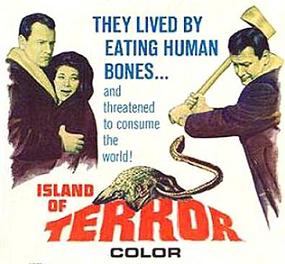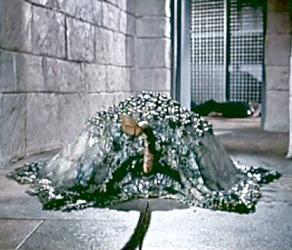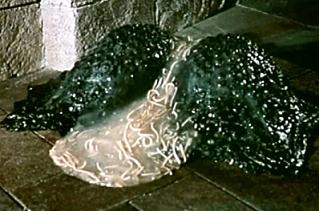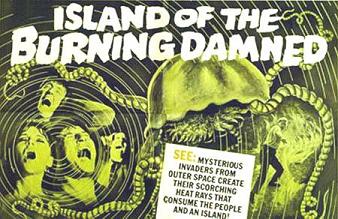Forgotten Horrors: Island of Terror
 Hammer Films dominated the British science fiction and horror movie industry from the 1950’s through the 1970’s. There were many competing companies that tried to emulate their successful formula and reap similar profits. Some of these studios, like Amicus, prospered for many years and turned out a sizable catalog of films. Others though only produced a handful of motion pictures and then lapsed into obscurity. One of these latter companies was Planet Film Productions, a small player in the British film scene but one which managed to leave a few horror fans with memories on both sides of the water.
Hammer Films dominated the British science fiction and horror movie industry from the 1950’s through the 1970’s. There were many competing companies that tried to emulate their successful formula and reap similar profits. Some of these studios, like Amicus, prospered for many years and turned out a sizable catalog of films. Others though only produced a handful of motion pictures and then lapsed into obscurity. One of these latter companies was Planet Film Productions, a small player in the British film scene but one which managed to leave a few horror fans with memories on both sides of the water.
Like most of the imitators, Planet Film Productions tried to give their films the same look as a Hammer production and this extended to employing some of their more recognizable stars. For the 1966 film Island of Terror, Planet used the bulk of their casting budget to hire Peter Cushing, who had recently made his mark as both Baron Frankenstein and Dr. Van Helsing for Hammer. His role of pathologist Dr. Stanley may not have proved as long lasting as his Hammer characters but at least he got to battle a less traditional monster.
 Based on a screenplay called Night of the Silicates, Island of Terror tells the story of an isolated community on the remote Petrie’s Island. There are no phones on the island and only one regular boat to be used for emergencies. They have a doctor and a police force composed of a single constable. There is also an advanced research facility on the island that is using radioactive material to create a living organism to combat cancer.
Based on a screenplay called Night of the Silicates, Island of Terror tells the story of an isolated community on the remote Petrie’s Island. There are no phones on the island and only one regular boat to be used for emergencies. They have a doctor and a police force composed of a single constable. There is also an advanced research facility on the island that is using radioactive material to create a living organism to combat cancer.
When a local farmer is found dead in a cave and his body appears to no longer have bones, the island’s doctor travels to the mainland to seek help from Cushing’s Dr. Stanley. The two return with an osteopath friend of Stanley’s, Dr. West, and his wealthy girlfriend via her family’s helicopter. When the quartet is dropped off, the copter is needed elsewhere and, with the launch gone, the island is now temporarily completely cut off from the outside world.

Not only are these things hard to kill but they bleed chicken noodle soup!
Once the two specialists arrive, the investigation begins and other victims, both human and animal, are discovered with the same bizarre lack of bones. A trip to the research facility reveals it in shambles and all of the staff dead but the notes of their experiments are recovered. The scientists set up headquarters at the local tavern and continue their research as the bodies pile up. On a return trip to the lab in search of the missing constable, the group discovers the source of the deaths – a turtle like creature with a single, tentacle appendage. In their attempt to escape, the town’s doctor is killed when he attacks one of the monsters with a fire axe and discovers it is much harder to kill than it looks!
Fleeing back to town, Drs. Stanley and West rally the islanders and review the notes for useful information. The creatures, called silicates, are a silicon based life form that feed on the calcium in bones. Their tentacles are cable of injecting a toxin that liquefies bone and then extracts the fluid, leaving behind an empty husk. Unfortunately the notes give no indication as to how to stop these monsters which appear to be dividing at an alarming rate and rapidly covering the island.

This is one silicate who won't come along quietly!
A small militia is formed to find a way of dealing with the silicates but the group meets with complete failure. Bullets, gasoline, and even dynamite have no effect on the monsters and they are marching ever closer to the heavily populated areas in search of food. When one of the creatures is found dead next to the half eaten corpse of an irradiated dog that had escaped from the research lab, they realize that isotopes will kill them if they are ingested.
The scientists and surviving townspeople inject the island’s cattle with radioactive isotopes from the lab and leave them in the creatures’ path. The silicates attack the livestock but initially appear unharmed and continue to where the remaining humans have barricaded themselves inside the town hall. Just as the beasts begin crashing the party, their lethal lunch catches up with them and kills them in the nick of time. The film’s final scene puts a damper on the outlook though when a similar facility in Japan makes the same mistake the one on the island did only in a much larger area.
 While the film attempts to copy much of Hammer’s style and atmosphere, it does offer a few moments of originality. The design of the silicates is unique and, coupled with the trilling noise heard whenever they are about to attack, does provide a surprising sense of menace. The boneless bodies are also disturbing, looking like discarded rubber suites as they lay deflated on the ground. There isn’t much room in the story for sex and the violence is not graphic but there are still plenty of scenes of unlucky townspeople on the wrong end of the silicates tentacles to keep things interesting.
While the film attempts to copy much of Hammer’s style and atmosphere, it does offer a few moments of originality. The design of the silicates is unique and, coupled with the trilling noise heard whenever they are about to attack, does provide a surprising sense of menace. The boneless bodies are also disturbing, looking like discarded rubber suites as they lay deflated on the ground. There isn’t much room in the story for sex and the violence is not graphic but there are still plenty of scenes of unlucky townspeople on the wrong end of the silicates tentacles to keep things interesting.
Island of Terror was released theatrically in the United States on a double bill with another film from a minor British studio, The Projected Man. The following year, in 1967, Planet Films would trot out this formula again for Night of the Big Heat. This one also had scientists trapped on an isolated island but this time it was Christopher Lee fighting extraterrestrials (Peter Cushing was also back in a supporting role). It took Night four years to make it stateside, where it was dusted off, retitled Island of the Burning Damned, and paired with another cinematic orphan, Godzilla’s Revenge. Interestingly, Planet Films either tried to save money on the advertising artwork or mixed them up because the creature on the poster is clearly a silicate with three extra tentacles added and looks nothing like the glowing alien blobs of Night of the Big Heat! Because of this, the two films have been erroneously mistaken for one another for years and this is further complicated by the fact that neither is readily available on home video in the US.
